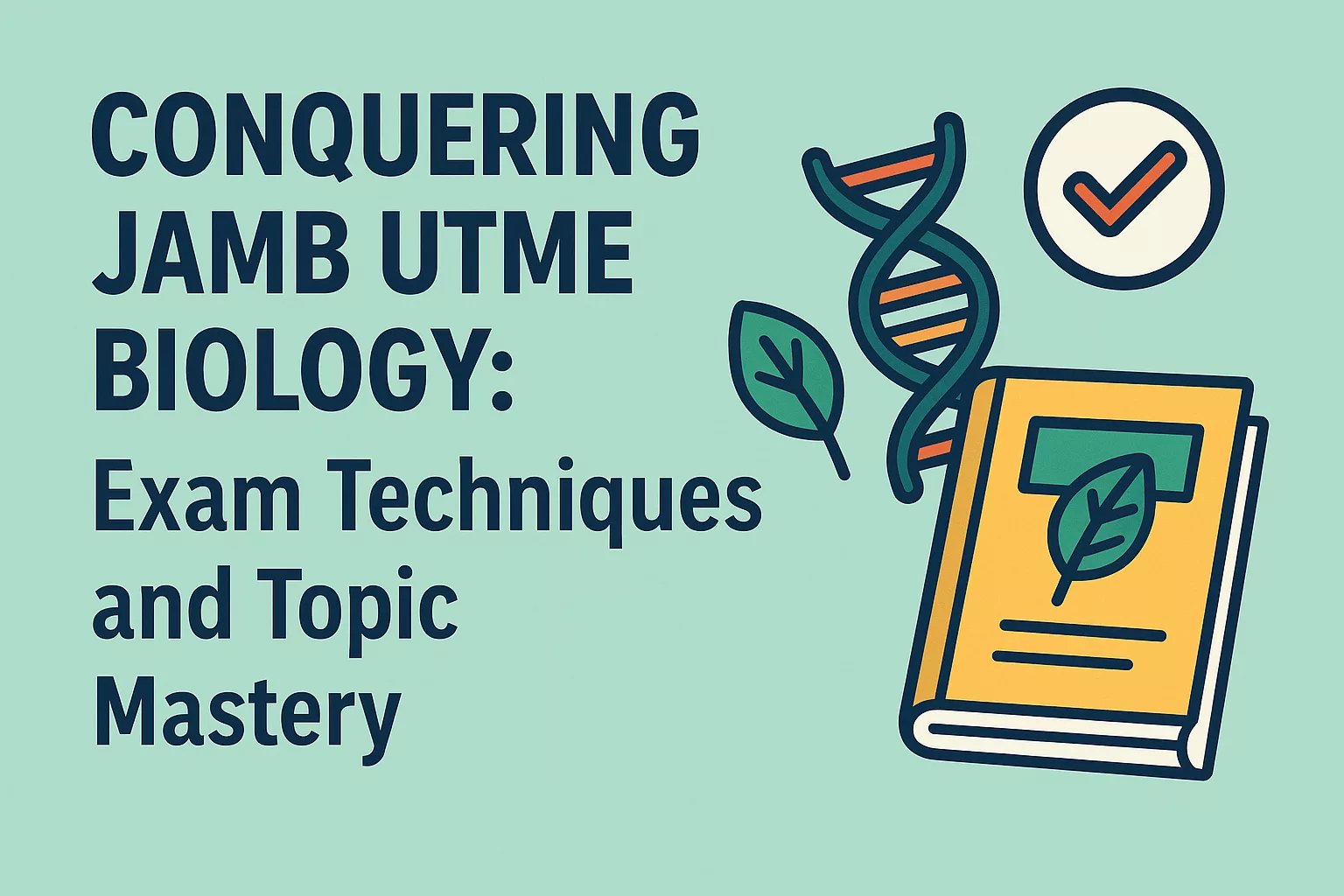1. Introduction
Biology is a core subject for many UTME candidates aiming for medicine, agriculture, or natural sciences. With its blend of factual recall, conceptual understanding, and practical application, Biology tests your ability to think like a scientist under timed conditions. A robust grasp of cellular processes, ecology, genetics, and physiology can propel your score and boost your overall aggregate.
In this guide, we break down the Biology syllabus, unpack common question formats, and share targeted strategies to master diagrams, interpret data, and write concise explanations. You’ll learn how to allocate study time wisely, identify high‑yield topics, and tackle even the trickiest multiple‑choice questions with confidence.
By integrating active revision techniques with exam‑smart practice, you’ll transform memorization into meaningful understanding. Let’s begin your journey to JAMB Biology excellence.
2. Deep Dive: Core Topics & Concept Breakdown
2.1 Cell Biology and Biochemistry
- Structure of prokaryotic and eukaryotic cells: organelles and their functions
- Cell membrane dynamics: diffusion, osmosis, active transport
- Biomolecules: carbohydrates, proteins, lipids, nucleic acids—structure and roles
- Enzyme kinetics: factors affecting rate, concept of activation energy
Practice Activity
- Draw and label a typical plant and animal cell, noting differences.
- Explain how temperature affects enzyme activity using the graph of rate vs. temperature.
2.2 Genetics and Evolution
- Mendelian genetics: monohybrid and dihybrid crosses, Punnett squares
- DNA structure and replication: semi‑conservative model, key enzymes
- Gene expression: transcription and translation processes
- Principles of natural selection and speciation
Worked Example
Problem: In peas, yellow (Y) is dominant to green (y). Cross two heterozygous plants. Determine genotypic and phenotypic ratios.
Solution: Genotypic ratio 1:2:1 (YY:Yy:yy), phenotypic ratio 3:1 (yellow:green).
2.3 Physiology and Homeostasis
- Human systems overview: circulatory, respiratory, digestive, nervous
- Homeostatic mechanisms: negative feedback in temperature regulation and blood sugar control
- Plant physiology: transpiration, translocation, photosynthesis light and dark reactions
Key Concept
Compare and contrast open and closed circulatory systems across animal phyla.
2.4 Ecology and Environment
- Ecosystem dynamics: food chains, food webs, energy flow, trophic levels
- Population ecology: growth curves, carrying capacity, limiting factors
- Biogeochemical cycles: water, carbon, nitrogen cycles
- Conservation biology: biodiversity importance, human impacts, sustainable practices
Data Interpretation
Analyze a graph showing logistic population growth; identify phase and factors causing plateau.
3. Exam Strategy Tips
3.1 Time Management and Section Order
Aim to spend 60–70 seconds per question. Begin with questions you find easiest to secure quick marks. Flag difficult ones and revisit if time permits.
3.2 Diagram and Data Questions
- Label diagrams neatly and use pencil for precision. Learn standard symbols (e.g., arrows for flow, bars for ribosomes).
- For charts or tables, read the title and axes first. Note units and scales before answering.
3.3 Eliminating Wrong Options
- Use biological principles to rule out answers that violate conservation laws (mass, energy) or cell theory.
- In genetics, check that ratios add up to 16 squares in dihybrid crosses before selecting.
3.4 Writing Short Answers
- Stick to the command word: “describe” (state features), “explain” (state reason), “compare” (highlight similarities and differences).
- Use bullet points for clarity when allowed.
3.5 Managing Exam Stress
- Take micro‑breaks: look away for 5 seconds after each passage.
- Use positive affirmations: “I know my biology.”
4. Subject‑Specific Overview
4.1 Cellular Processes
Understand the relationship between structure and function. For example, microvilli increase surface area for absorption.
4.2 Genetic Calculations
Practice blood group inheritance and epistasis problems beyond basic Mendelian crosses.
4.3 Human Physiology Applications
Link physiological concepts to real‑world scenarios, like the effect of altitude on oxygen uptake.
4.4 Ecological Case Studies
Study landmark experiments (e.g., Gause’s Paramecium) to answer application questions.
5. Practice & Resources
5.1 Past Question Compilations
JAMB Past Questions – Biology Volume 1–4 by Success Publications
5.2 Interactive Online Tools
| Resource | Features | Access |
|---|---|---|
| Biologynotes | Animated concept videos | Free |
| myCBTPrep | Timed mock exams in Biology | Free/Paid |
| Khan Academy | In‑depth lessons on all topics | Free |
5.3 Mobile Apps
- Complete Biology: Quick quizzes and flashcards.
- Biology Dictionary: Pocket reference for definitions.
5.4 Mock Exam Plan
Schedule three full‑length mock tests with peer review sessions. Review errors by topic and revisit weak areas.
6. Conclusion
Biology in the JAMB UTME tests both memorization and analytical skills. By mastering cell biology, genetics, physiology, and ecology and practicing diagram interpretation, data analysis, and short‑answer techniques you’ll develop the confidence to approach any question.
Establish a balanced study routine: alternate reading theory with practical questions, schedule regular mock exams, and engage with diverse resources. Track your progress, adjust your study plan based on performance, and reinforce core concepts.
Apply one new technique this week: draw and label a cell diagram or analyze a population growth curve. With consistent effort and the strategies outlined, you’ll be positioned to achieve top marks in JAMB Biology.
